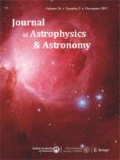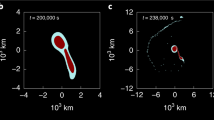Abstract
The giant impact hypothesis is the dominant theory explaining the formation of our Moon. However, the inability to produce an isotopically similar Earth–Moon system with correct angular momentum has cast a shadow on its validity. Computer-generated impacts have been successful in producing virtual systems that possess many of the observed physical properties. However, addressing the isotopic similarities between the Earth and Moon coupled with correct angular momentum has proven to be challenging. Equilibration and evection resonance have been proposed as means of reconciling the models. In the summer of 2013, the Royal Society called a meeting solely to discuss the formation of the Moon. In this meeting, evection resonance and equilibration were both questioned as viable means of removing the deficiencies from giant impact models. The main concerns were that models were multi-staged and too complex. We present here initial impact conditions that produce an isotopically similar Earth–Moon system with correct angular momentum. This is done in a single-staged simulation. The initial parameters are straightforward and the results evolve solely from the impact. This was accomplished by colliding two roughly half-Earth-sized impactors, rotating in approximately the same plane in a high-energy, off-centered impact, where both impactors spin into the collision.


Similar content being viewed by others
References
Benz, W., Slattery, W. L., Cameron, A. G. W. 1986, Icarus 66, 515
Bradley, J. 1748, Philos. Trans. R. Soc. London 45, 1
Cameron, A. G. W., Ward, W. R. 1976, Proc. Lunar Planet. Sci. Conf. 7, 120–122
Canup, R. M. 2004, Icarus 168, 433–456
Canup, R. M. 2008, Icarus 196, 518–538
Canup, R. M. 2012, Science 338, 1052–1055
Canup, R. M. 2013, Nature 504, 27–29
Canup, R. M., Asphaug, E. 2001, Nature 412, 708–712
Clery, D. 2013, Science 342, 183–185
Ćuk, M., Hamilton, D. P., Lock, S. J., Stewart, S. T. 2016, Nature 539, 402–406
Ćuk, M., Stewart, S. T. 2012, Science 338, 1047–1052
Darwin, G. H. 1879, Philos. Trans. R. Soc. London 170, 447–538
Eiland, J. C., Salzillo, T. C., Hokr, B. H., Highland, J. L., Mayfield, W. D., Wyatt, B. M. 2014, J. Astrophys. Astr. 35, 607–618
Elliott, T., Stewart, S. T. 2013, Nature 504, 90–91
Goldreich, P. 1966, Rev. Geophys. 4, 411–439
Hartmann, W. K., Davis, D. R. 1975, Icarus 24, 504–515
Jutzi, M., Asphaug, E. 2011, Nature 496, 69–71
Kokubo, E., Ida, S., Makino, J. 2000, Icarus 148, 419–436
Lugmair, G. W., Shukolyukov, A. 1998, Geochim. Cosmochim. Acta 62, 2863–2886
Meier, M. M. M. 2012, Nat. Geosci 5, 240–241
Pahlevan, K., Stevenson, D. J. 2007, Earth Planet. Sci. Lett. 262, 438–449
Reufer, A., Meier, M. M. M., Benz, W., Wieler, R. 2012, Icarus 221, 296–299
Rufu, R., Aharonson, O., Perets, B. H. 2017, Nature Geoscience 10, 89–94
Stevenson, D. J. 1987, Ann. Rev. Earth Planet. Sci. 15, 271–300
Stevenson, D. J. 2014, Physics Today 67, 32–38
Stevenson, D. J., Halliday, A. N. 2014, Phil. Tran. R. Soc. A 372, 1–3
Touma, J., Wisdom, J. 1994, Astron. J. 108, 1943–1961
Walker, J. C. G., Zahnle, K. J. 1986, Nature 320, 600–602
Wang, K., Jacoben, S. B. 2016, Nature 538, 487–490
Wiechert, U., Halliday, A. N., Lee, D. C., Snyder, G. A., Taylor, L. A., Rumble, D. 2001, Science 294, 345–348
Young, E. D., Kohl, I. E., Warren, P. H., Rubie, D. C., Jacobson, S. A., Morbidelli, A. 2016, Science 351, 493–496
Zhang, J., Dauphas, N., Davis, A. M., Leya, I., Fedkin, A. 2012, Nat. Geosci 5, 251–255
Acknowledgements
We thank NVIDIA and Mellanox Technologies for the donation of hardware; Tarleton State University’s high-performance computing lab for space; Tarleton State University’s Office of Research and Innovation, and The Program for Astronomy Education and Research for funding; Robert W. Muth for insightful remarks and suggestions; and special thanks to The Wyatt Fund for supporting student travel.
Author information
Authors and Affiliations
Corresponding author
Appendix A. Methods
Appendix A. Methods
To perform an extensive search of the initial parameter space, we sought a simulation method that was computationally inexpensive and easily parallelized to run on modern graphics processing units. Eiland et al.’s (2014) method was ideal for this purpose because it adopts a simplified approach to thermodynamics, yet is otherwise physically realistic. Another advantage of Eiland’s method is that it frequently produces a fully formed Moon, whereas other methods typically only produce a circumplanetary disk of debris. The parameter settings used with Eiland’s method are listed in Table 3.
The simulation code was written in C, C++, and Compute Unified Device Architecture (CUDA). The simulations were run on workstations housing CUDA-enabled NVIDIA graphics processing units (GPUs). The graphics code was written in C and C++ and displayed using OpenGL. Gravity was not approximated; the full all-pairs n-body problem was used. This was numerically integrated through time using the leapfrog formulas.
The input parameters were: the number of computational-elements, mass of impactor 1, mass of impactor 2, iron/silicate ratio by mass of impactor 1, iron/silicate ratio by mass of impactor 2, density of iron material, and density of silicate material (see Table 1 and Table 3). Using these inputs, a common radius for all computational-elements was determined. The correct number of silicate and iron computational-elements was then designated to create each impactor.
Given the computational-elements assignments, we first randomly placed the iron computational-elements into two separate spheres that would become the cores of impactor 1 and impactor 2. The radii of these spheres were calculated by doubling the radii determined by a 68% packing ratio for their respective iron computational-elements. Next, the silicate computational-elements were placed to create the mantles of impactor 1 and impactor 2. These computational-elements were placed outside the core spheres but inside spheres whose radii were calculated by doubling the radii determined by a 68% packing ratio for the impactors’ total computational-elements, respectively. If a computational-element was randomly placed less than a diameter from an existing computational-element, a new position was randomly selected until the computational-element was successfully placed.
The computational-elements positioned in these unnatural, randomly selected positions had high potential energy. This energy was removed by allowing the internal computational-elements of each impactor to interact under a large damping constraint for 20 simulated hours. This damping constraint was then removed and the impactors were again allowed to run for 50 simulated hours to remove any residual effects caused by the damping component. The impactors were then spun and allowed to settle into their spins for 50 simulated hours. During this building process, impactors were isolated from each other. The final step was to give impactors initial positions and velocities. All computational-elements were then allowed to interact, starting the simulation. Positions and velocities were periodically stored to create videos and to gather statistics.
Rights and permissions
About this article
Cite this article
Wyatt, B.M., Petz, J.M., Sumpter, W.J. et al. Creating an isotopically similar Earth–Moon system with correct angular momentum from a giant impact. J Astrophys Astron 39, 26 (2018). https://doi.org/10.1007/s12036-018-9515-8
Received:
Accepted:
Published:
DOI: https://doi.org/10.1007/s12036-018-9515-8




